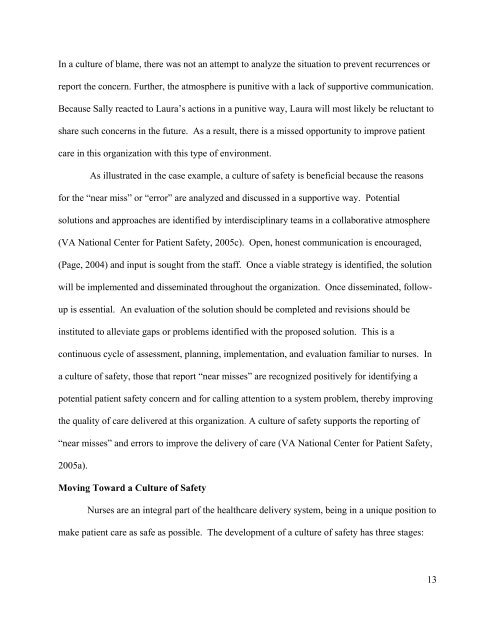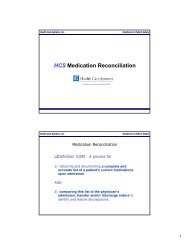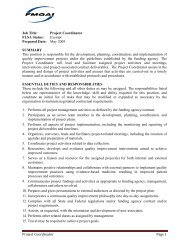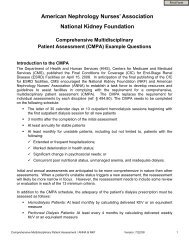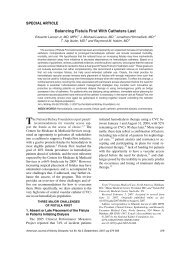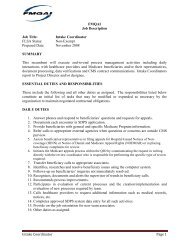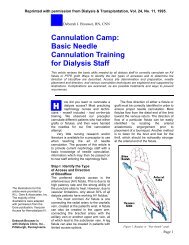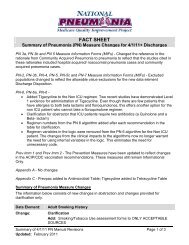The Nurse's Role in Promoting a Culture of Patient Safety - FMQAI
The Nurse's Role in Promoting a Culture of Patient Safety - FMQAI
The Nurse's Role in Promoting a Culture of Patient Safety - FMQAI
Create successful ePaper yourself
Turn your PDF publications into a flip-book with our unique Google optimized e-Paper software.
In a culture <strong>of</strong> blame, there was not an attempt to analyze the situation to prevent recurrences or<br />
report the concern. Further, the atmosphere is punitive with a lack <strong>of</strong> supportive communication.<br />
Because Sally reacted to Laura’s actions <strong>in</strong> a punitive way, Laura will most likely be reluctant to<br />
share such concerns <strong>in</strong> the future. As a result, there is a missed opportunity to improve patient<br />
care <strong>in</strong> this organization with this type <strong>of</strong> environment.<br />
As illustrated <strong>in</strong> the case example, a culture <strong>of</strong> safety is beneficial because the reasons<br />
for the “near miss” or “error” are analyzed and discussed <strong>in</strong> a supportive way. Potential<br />
solutions and approaches are identified by <strong>in</strong>terdiscipl<strong>in</strong>ary teams <strong>in</strong> a collaborative atmosphere<br />
(VA National Center for <strong>Patient</strong> <strong>Safety</strong>, 2005c). Open, honest communication is encouraged,<br />
(Page, 2004) and <strong>in</strong>put is sought from the staff. Once a viable strategy is identified, the solution<br />
will be implemented and dissem<strong>in</strong>ated throughout the organization. Once dissem<strong>in</strong>ated, follow-<br />
up is essential. An evaluation <strong>of</strong> the solution should be completed and revisions should be<br />
<strong>in</strong>stituted to alleviate gaps or problems identified with the proposed solution. This is a<br />
cont<strong>in</strong>uous cycle <strong>of</strong> assessment, plann<strong>in</strong>g, implementation, and evaluation familiar to nurses. In<br />
a culture <strong>of</strong> safety, those that report “near misses” are recognized positively for identify<strong>in</strong>g a<br />
potential patient safety concern and for call<strong>in</strong>g attention to a system problem, thereby improv<strong>in</strong>g<br />
the quality <strong>of</strong> care delivered at this organization. A culture <strong>of</strong> safety supports the report<strong>in</strong>g <strong>of</strong><br />
“near misses” and errors to improve the delivery <strong>of</strong> care (VA National Center for <strong>Patient</strong> <strong>Safety</strong>,<br />
2005a).<br />
Mov<strong>in</strong>g Toward a <strong>Culture</strong> <strong>of</strong> <strong>Safety</strong><br />
Nurses are an <strong>in</strong>tegral part <strong>of</strong> the healthcare delivery system, be<strong>in</strong>g <strong>in</strong> a unique position to<br />
make patient care as safe as possible. <strong>The</strong> development <strong>of</strong> a culture <strong>of</strong> safety has three stages:<br />
13


